Mashed Potatoes Recipe (Creamy & Fluffy)
Fluffy, creamy, and indescribably cozy, my herb and garlic Mashed Potatoes recipe is one that you’re sure to love. This easy recipe can be made in one pan or pot under 30 minutes, making it the perfect way to add a little starchy goodness to any weeknight meal.
About Mashed Potatoes Recipe
Potatoes are one of my favorite veggies – they’re starchy, filling, and oh so versatile. You can add them to rice, curries, sandwiches, or even raita.
As much as I love the humble spud in all its many forms, I hold a special place in my heart for mashed potatoes.

Basic mashed potatoes are simply made with potatoes, milk, butter, salt and pepper. The potatoes are cooked till tender. The cooked potatoes are then strained and mashed with warm milk, butter, salt and pepper.
Once you know the basic formula for making what I affectionately call “mashies,” there are tons of ways for you to spice them up to your own liking. Here’s what I like to add to mine:
- Garlic – Garlic adds a lovely mildly nutty flavor to these mashed potatoes to take their flavor over the top. Feel free to swap in other alliums of your choice – chives are another excellent option, as are caramelized onions.
- Herbs – Personally I prefer to use fresh herbs, but you can certainly use dried if you don’t have any fresh on hand. The herbs can change depending on your mood and what you are serving with your mashed potatoes. Try anything from cilantro or parsley to tarragon or rosemary.
- Black pepper – When it comes to black pepper, freshly crushed is the name of the game; it just has so much more flavor than ground black pepper powder!
- Fat – You can use either or both butter and extra virgin olive oil (evoo). I have made mashed potatoes with both on various occasions and both work fine.
- Milk – For a rich, creamy version, I suggest using whole milk. For vegan mashed potatoes, coconut milk or almond milk works well. Please note that with coconut milk, you will get a slight coconut taste in the mashed potatoes.
I generally make enough quantity of mashed potatoes so that there are no leftovers. Yet, one can easily half or double or triple this recipe and make it for small parties or gatherings.
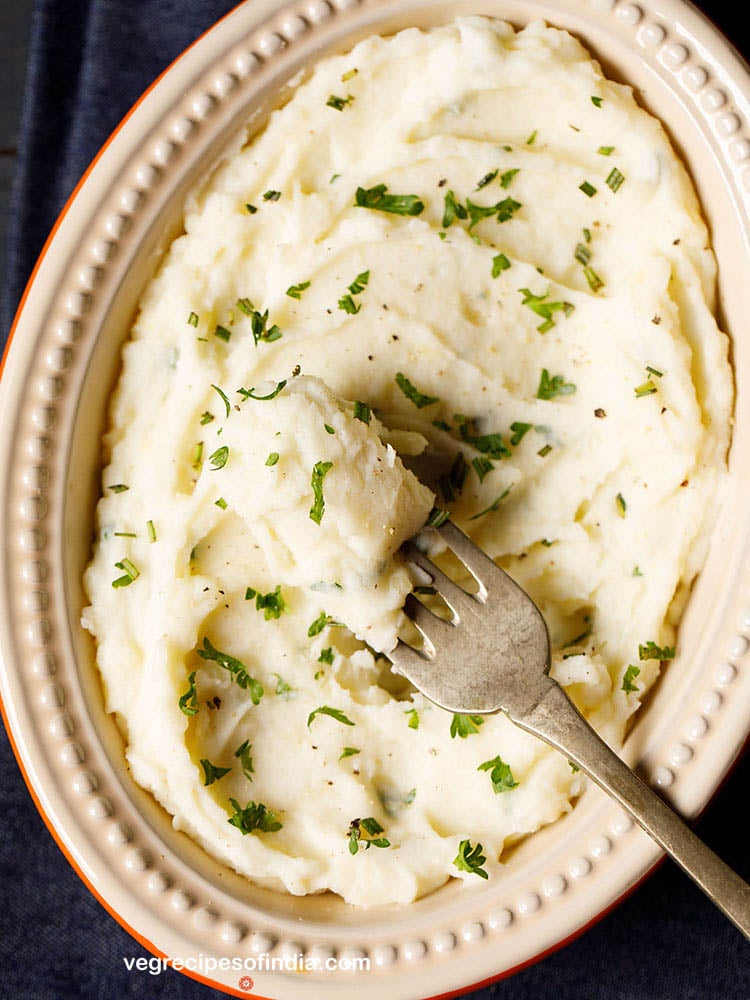
How To Make Mashed Potatoes
Making flavored mashed potatoes is quite easy. Here’s how it’s done:
Prep Potatoes
1. Rinse 500 grams of potatoes in water using a colander. Brush off any mud if needed. Rinse well. Drain the water and then peel the potatoes.
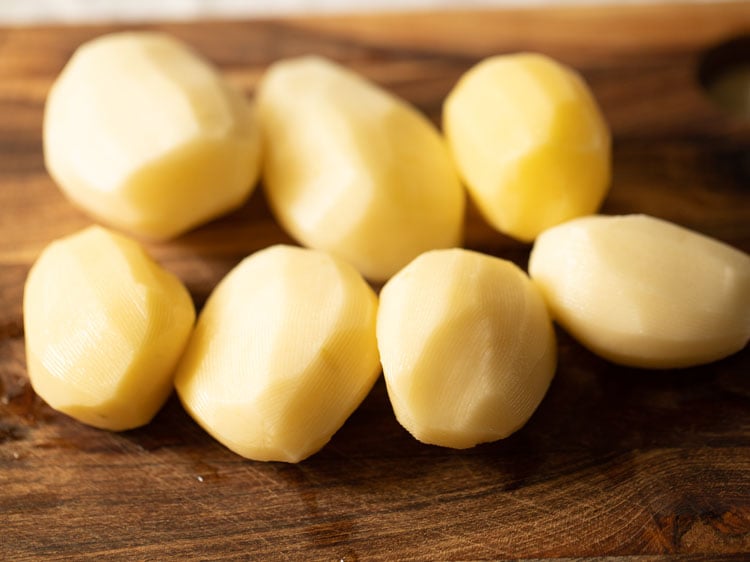
2. Chop them in 1.5 to 2 inches cubes.
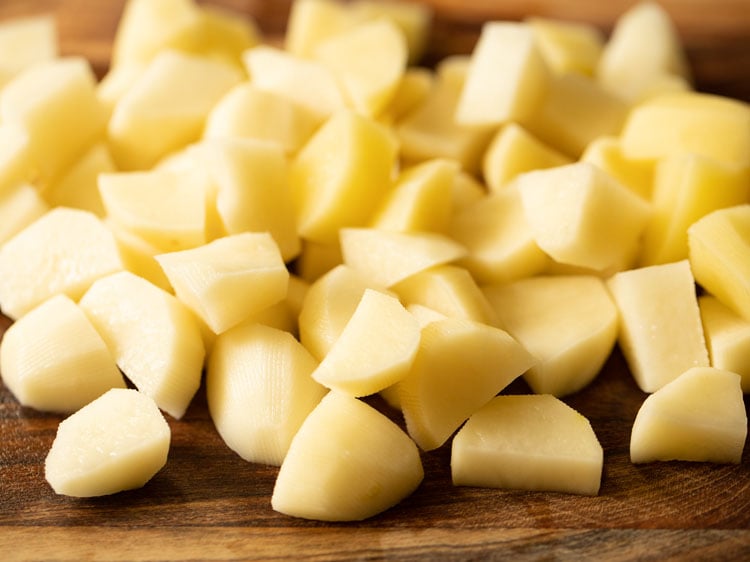
3. Place chopped potatoes in a pan (3 litres or 3 quarts size). Add ½ teaspoon salt.
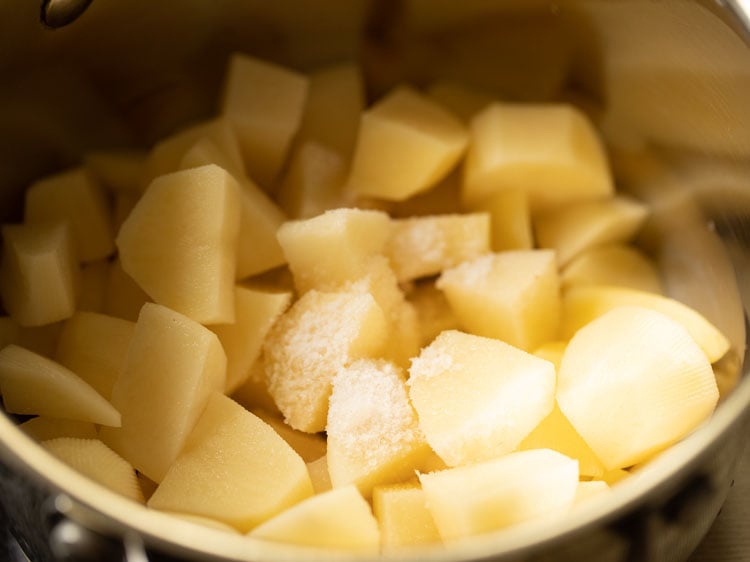
4. Pour in 2 cups of water and stir to combine. The water should just about cover the potatoes. Add water more or less depending on the size of the pan.
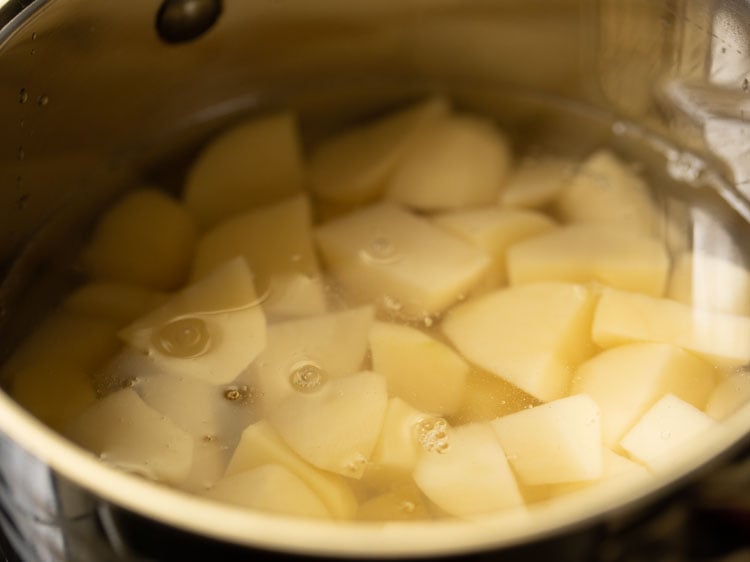
Cook Potatoes
5. Cover the pan. Keep the pan on a stovetop on a medium-low to medium heat for the potatoes to cook.
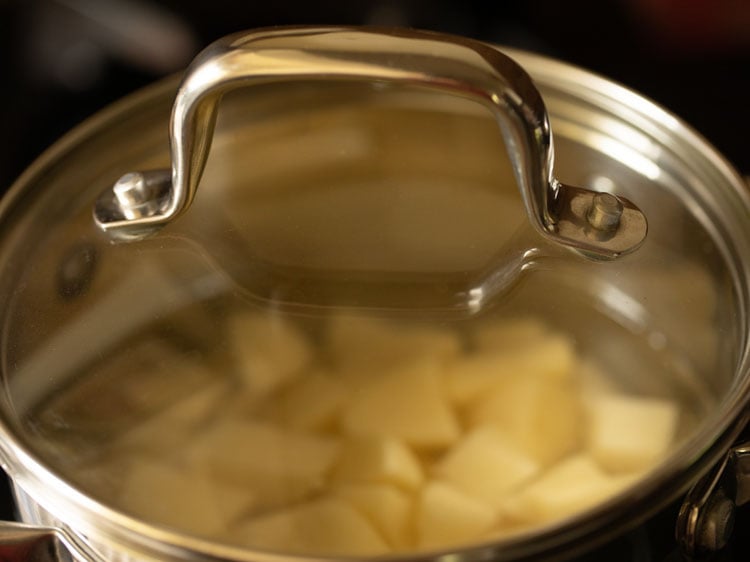
6. While the potatoes are cooking, check at intervals to ensure they don’t overcook. Meanwhile, you can chop garlic and fresh herbs, if using.
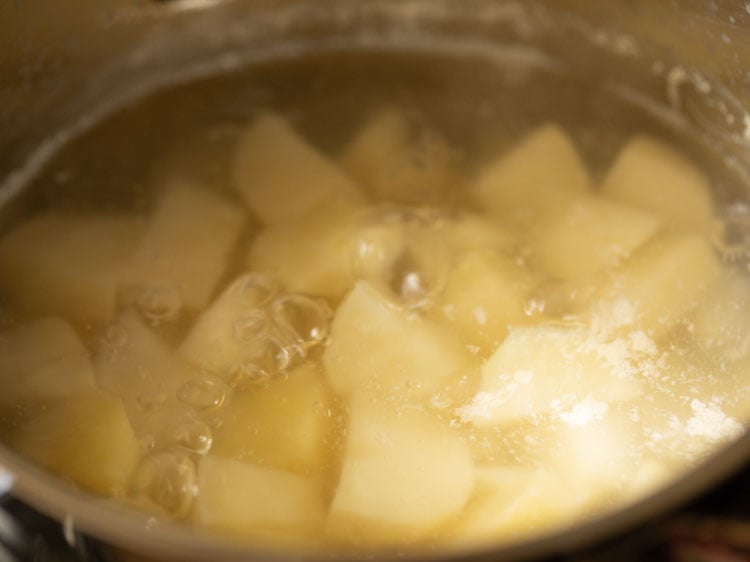
7. The potatoes have to be softened, but they should not fall apart.
The potatoes will take about 20 to 25 minutes to cook depending on the size of the pan, the thickness of pan and the intensity of the heat.
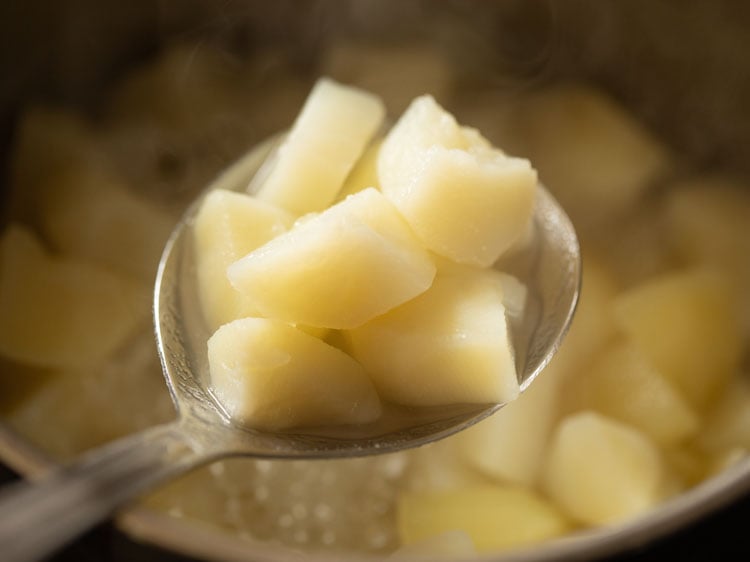
8. Check by piercing a knife or a fork; it should smoothly pass through the cooked potatoes without any resistance.
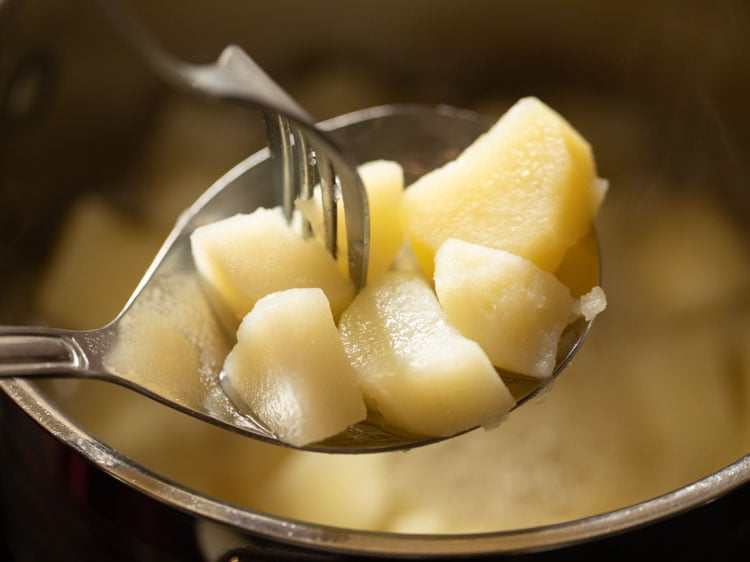
9. Pour the contents of the pan in a colander and drain the water very well.
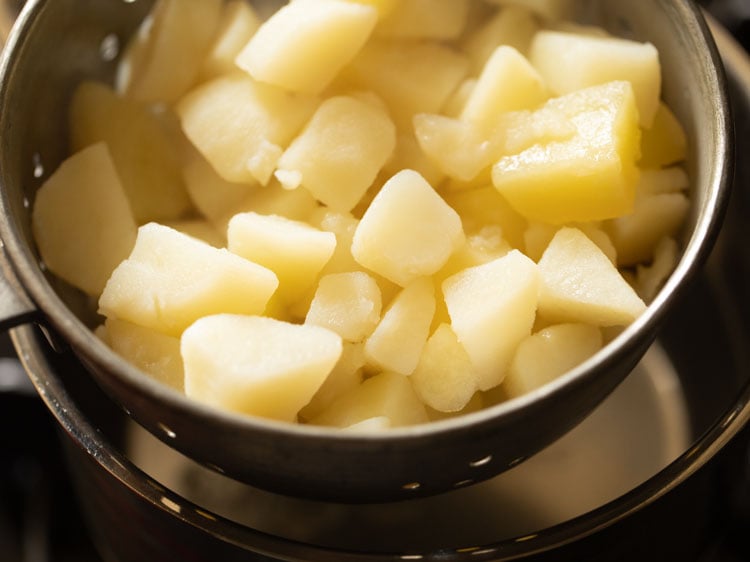
Cook Milk and Butter
10. In the same pan in which the potatoes were cooked (no need to clean it first), add ½ cup + 2 tablespoons milk.
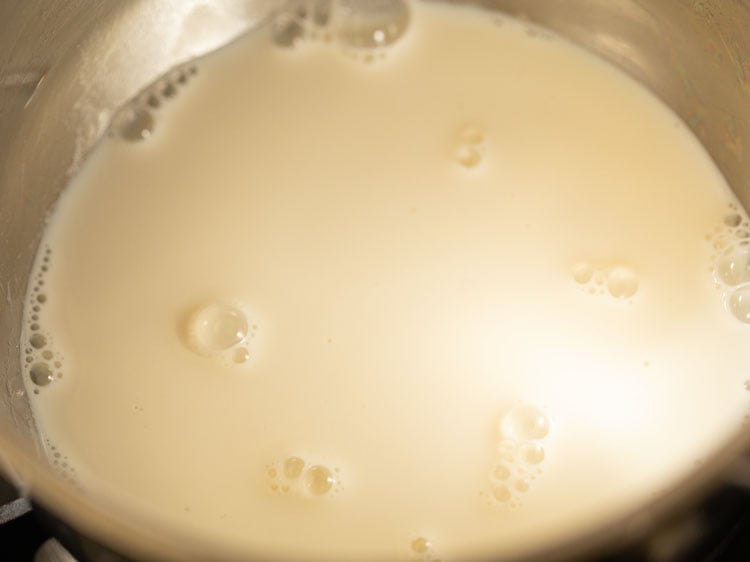
12. Add 2 tablespoons butter.
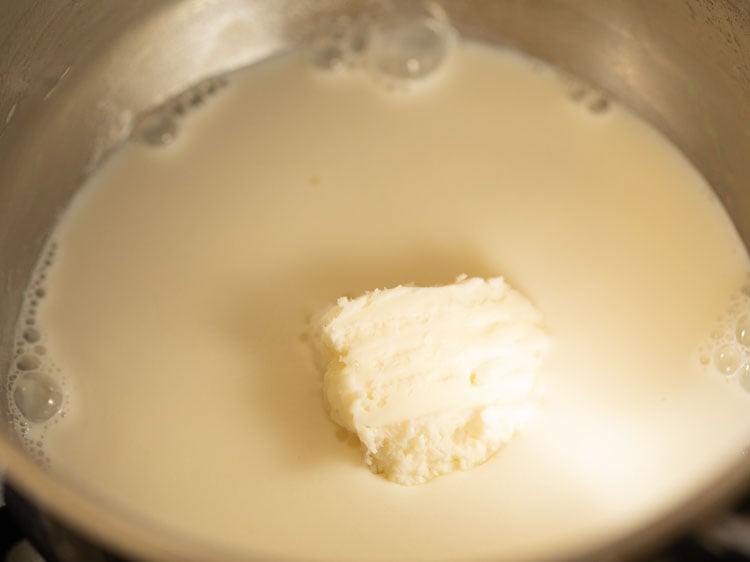
13. Add ½ teaspoon finely chopped or minced garlic. Please note that you can also add garlic to the boiling potatoes instead.
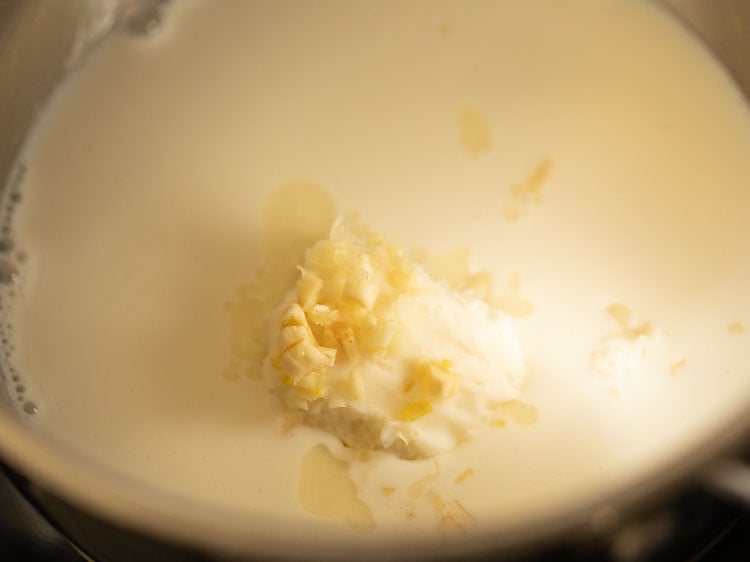
14. Heat on low or medium-low, stirring occasionally. The butter will begin to melt.

15. Let the milk+butter+garlic mixture become hot or come to a gentle boil.
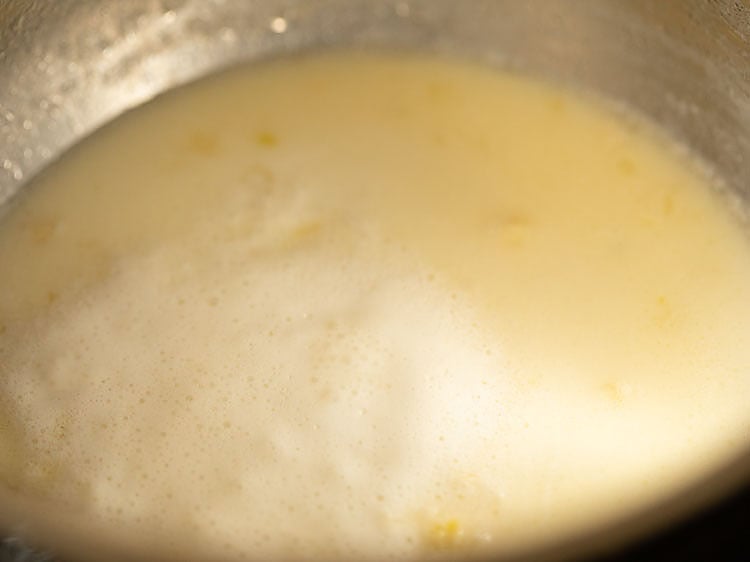
16. Now turn off the heat and add the potatoes to the pan with the milk, butter and garlic.
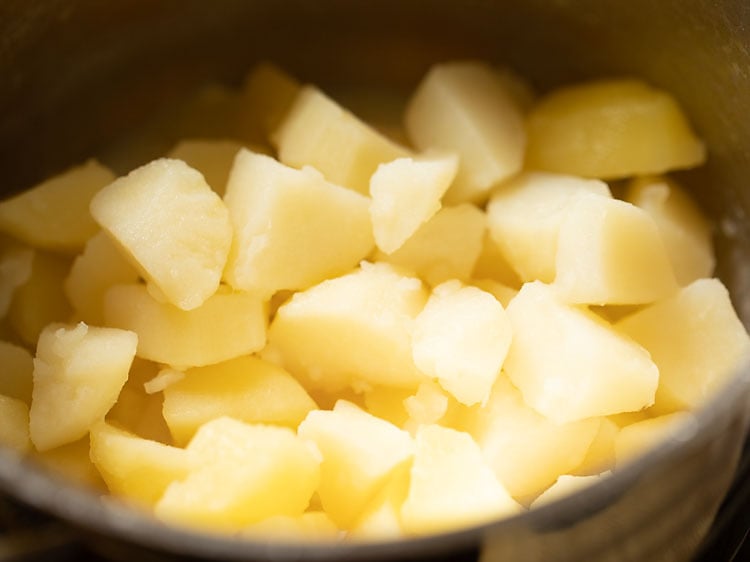
Make Mashed Potatoes
17. Remove the pan from the stovetop and place it on your kitchen countertop.
Begin to mash the potatoes with a potato masher, vegetable masher, or use a potato ricer if you have it instead of the masher.
Preferably the masher should have ricer like holes in it as this mimics the ricer while mashing.
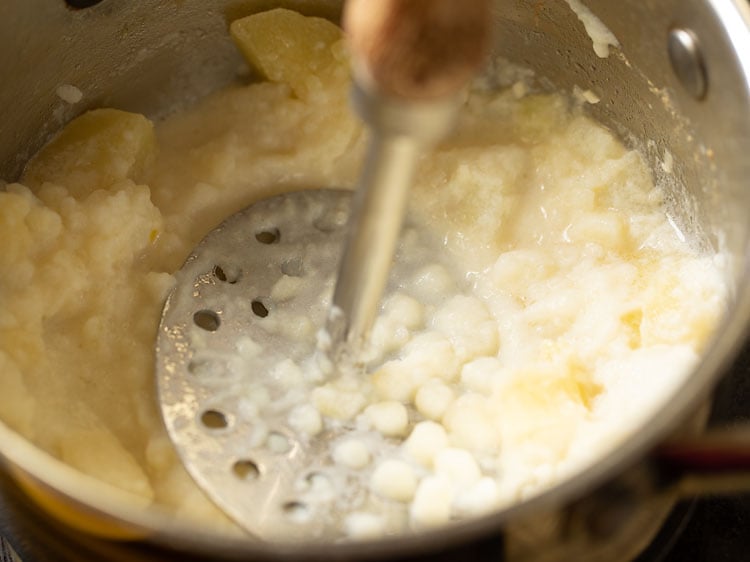
18. Mash till you get a smooth, fluffy and light consistency. Do not mash too much as this will break down the starches more and make for a gummy texture.
You can always add more butter and some warm milk to get your desired consistency.
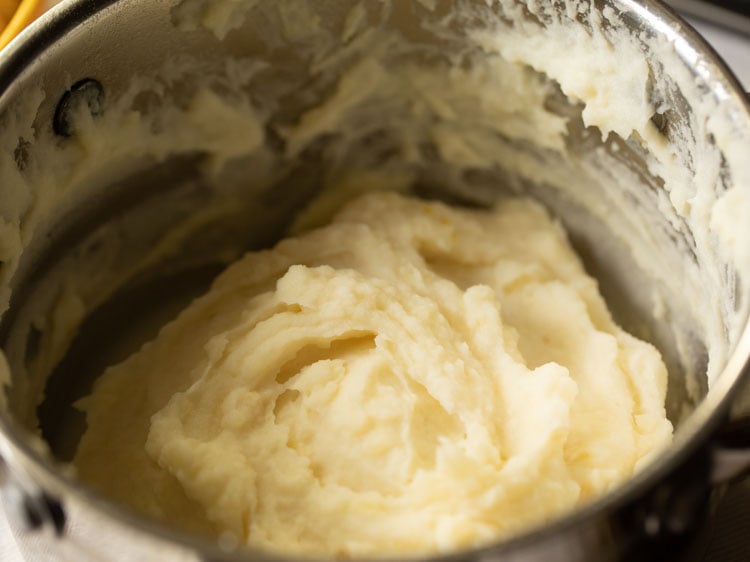
19. Sprinkle some freshly crushed black pepper and a bit of salt. Go easy on the salt as some saltiness will be there in the potatoes – remember we added salt while cooking potatoes.
You can always add more salt later after doing a taste test, but you can’t take it away.
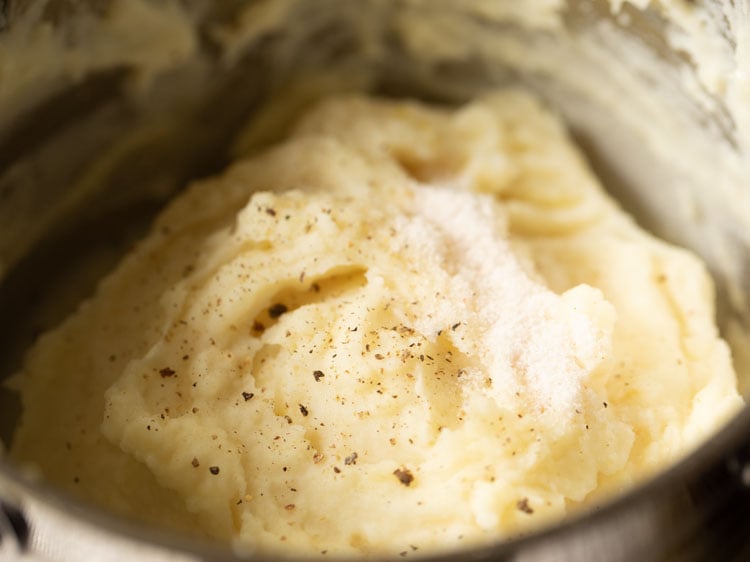
20. Add 2 to 3 teaspoons of fresh mixed herbs or ½ to 1 teaspoon of dried mixed herbs. I have used a mix of fresh rosemary and parsley here.
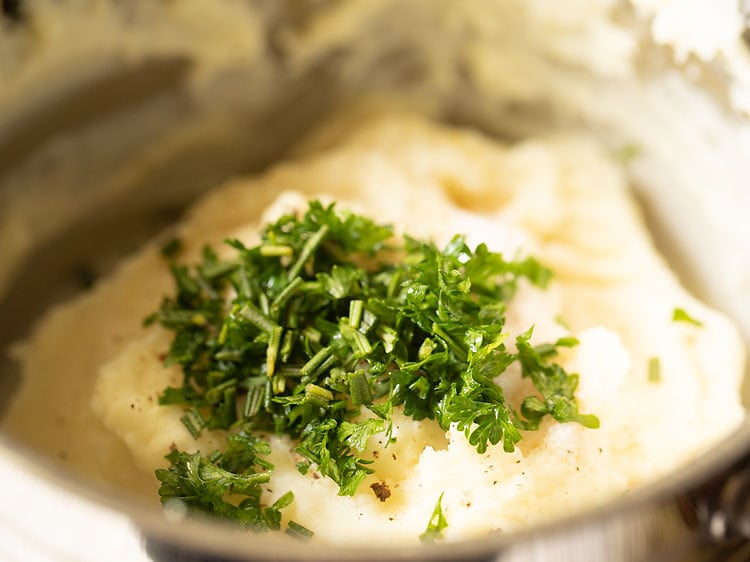
21. Fold in the herbs, pepper, and salt. Taste and season as needed, then serve.
These fluffy mashed potatoes should hold their shape, as shown in the photo below.
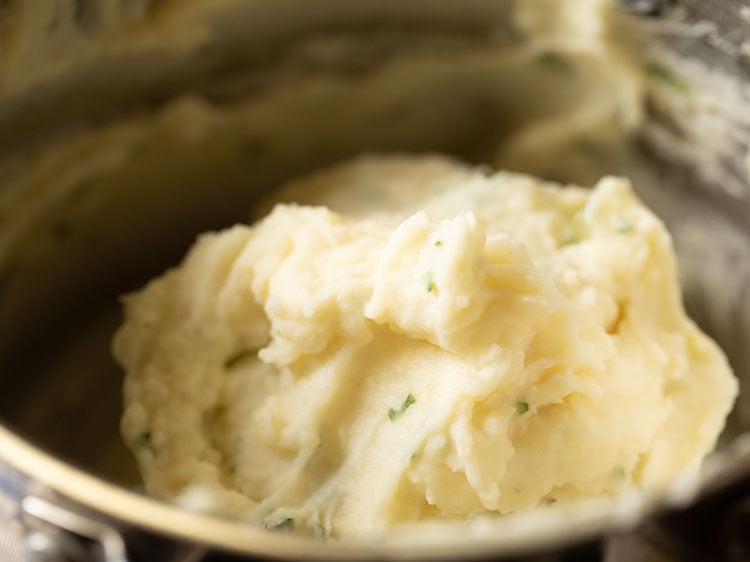
22. With a spatula, place the mashed potatoes in your serving bowl while still hot or warm.
Garnish with some chopped parsley or chives. You can also add some cubes of butter as a garnish.
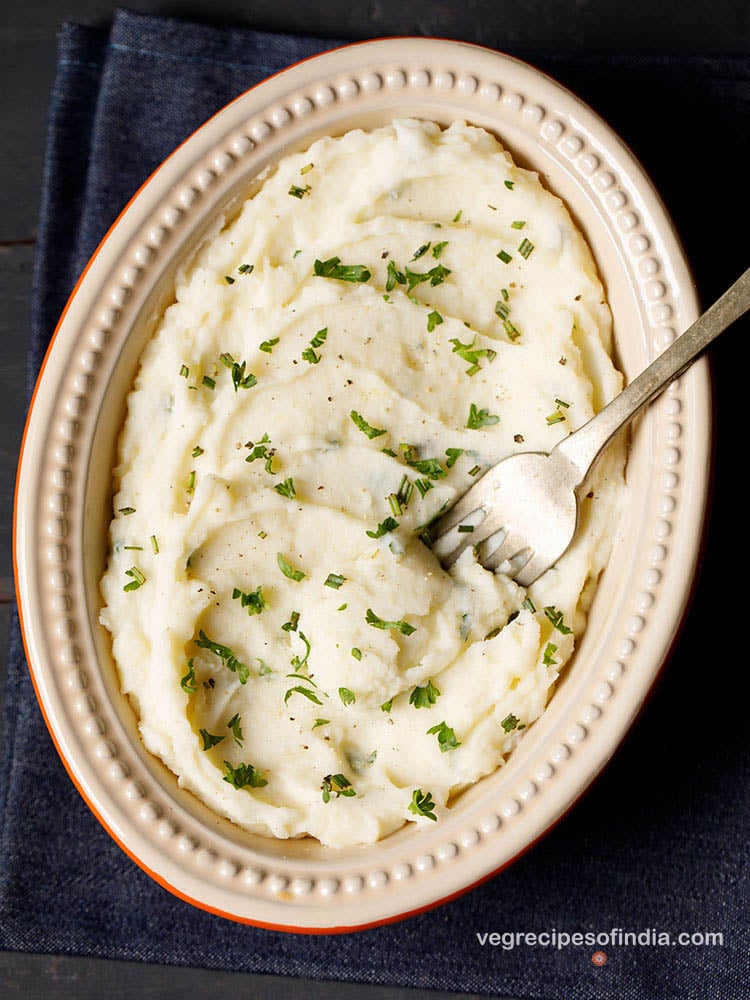
Serving Suggestions
I always serve mashed potatoes with some roasted vegetables and a bowl of soup like Corn Soup, Tomato Soup, or Carrot Soup, but it makes a pretty fabulous side for all kinds of tasty things. Here are some vegetarian options to consider:
- Roasted, grilled or steamed vegetables
- Creamed Spinach or creamed corn
- Vegetarian or vegan stroganoff
- A delish vegetarian meatballs and sauce
- Marinated & grilled tofu or paneer (Indian cottage cheese)
- You can even use this recipe of mashed potatoes for making dishes where mashed potatoes are required, like shepherd’s pie, pot pies, potato patties etc.
What do you like to serve with your mashed potatoes? Let us know in the comments below, or tag me on your social posts so I can cheer you on!
Expert Tips
- Use the right type of potatoes – To get the best mashed potatoes, you should use potatoes with medium to high starch levels like russets.
(For Indian readers, most varieties of Indian potatoes have good amount of starch in them.) Avoid using wax potatoes like new potatoes or fingerlings, as they can end up with a gluey consistency. - Boil potatoes till tender – Boil the potatoes till fork tender, but do not overcook them. If they are cooked till crumbly and water-logged, the mashed potatoes will have a watery taste and grainy consistency.
- Mash potatoes by hand – avoid using a stand mixer while mashing, as you’ll be more likely to overmix them, which will break down the starches and lead to a gluey and sticky consistency. It is better to use a potato masher.
- Texture of mashed potatoes – The final texture of mashed potatoes should be light and fluffy or creamy depending on the type of potato you have used. For a fluffy texture, use potatoes that have high starch in them (e.g. russet or Idaho potatoes).
For creamy and slightly dense texture, use potatoes with medium starch (e.g. yukon gold). You can also mix and match if you prefer. - Drain potatoes well – The starchy cooking water from boiling potatoes is neither tasty, nor good to add to the mashies. Be sure to drain them well.
More Tips
- Role of fats – Fats like butter or evoo need to be added to make the mashed potatoes light and smooth. Other options include sour cream or full-fat curd, cream cheese, or cream.
- Adding cheese or cream – I usually do not add grated cheese or cream, but you certainly can. If using cream, heat it gently with butter but do not bring it to a boil.
If using cheese, sprinkle it on the mashed potatoes and bake in the oven till the cheese melts or gets golden. Adding either cream or cheese will give you a rich-tasting mashed potato. - Cooking potatoes in a pressure cooker – most of the times, I cook the potatoes in a stovetop pressure cooker or instant pot. For this recipe post, I have used a pan to make it accessible to folks who do not have a pressure cooker. If pressure cooking, then cook for 2 whistles on medium heat.
- To peel or not to peel – I always suggest peeling the potatoes. Keeping the peels might give an unpleasant taste and texture in the mashed potatoes, but it is a personal preference. Do what suits you best!
FAQs
Can I make mashed potatoes ahead of time?
Leftover mashed potatoes can be refrigerated for up to 1 to 2 days and warmed in the oven just before serving. Feel free to add more milk or butter as needed to get them to the right consistency.
Why are my mashed potatoes runny?
Oops, sounds like you added a bit too much liquid. Don’t worry though, you can still salvage them.
Place them in a pan over low heat and warm them slowly, stirring occasionally to ensure they don’t stick to the bottom.
Over time, the excess moisture should evaporate, leaving you with perfect mashies!
What is the best kind of potato masher?
I prefer to use the type that has a vertical handle and that has small holes in the bottom, like a potato ricer.
If you like your mashed potatoes to be a little chunky, opt for a masher with a swirled, S-shaped bottom.
Step by Step Photo Guide Above
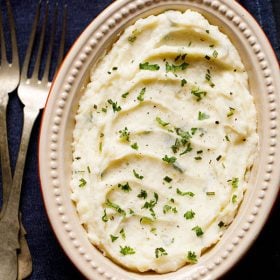
Ingredients
For cooking potatoes
- 500 grams potatoes or 1.1 pound or 6 to 7 medium sized potatoes (russet potatoes or potatoes with a high to medium starch content)
- 2 cups water
- ½ teaspoon salt
More ingredients
- ½ cup + 2 tablespoons whole milk
- 2 tablespoons Butter – salted or unsalted
- ½ teaspoon garlic – finely chopped or 3 to 4 small to medium garlic cloves, minced or finely chopped
- salt – add as required
- 2 to 3 teaspoons fresh herbs of your choice or or ½ to 1 teaspoon of dried mixed herbs
- black pepper (freshly crushed), add as required
Instructions
Preparation
- Rinse potatoes in water first using a colander. Brush off the mud if any. Drain the water and then peel the potatoes.
- Chop them in 1.5 to 2 to inches cubes.
- Place chopped potatoes in a pan.
- Add ½ teaspoon salt and 2 cups water. Stir to mix.
Cooking Potatoes
- Cover the pan. Keep pan on a stove top on a medium-low to medium heat for the potatoes to cook.
- While the potatoes are cooking, check at intervals. Meanwhile, you can chop garlic and the fresh herbs if using them.
- The potatoes have to be softened, but they should not fall apart.
- Check by piercing a knife or a fork and it should pass through the cooked potatoes without any resistance and smoothly.
- Pour the contents of the pan in a colander and drain the water very well.
Cooking milk and butter
- In the same pan in which the potatoes were cooked, add ½ cup + 2 tablespoons milk, 2 tablespoons butter and ½ teaspoon finely chopped or minced garlic
- Please note that you can add garlic even while boiling potatoes.
- On a low to medium-low heat begin to heat the pan. Stir occasionally. The butter will begin to melt initially.
- Let this mixture become hot or come to a gentle boil.
- Now turn off the heat and add the potatoes in the pan.
Mashing potatoes
- Remove the pan from the stovetop and place on your kitchen countertop. Begin to mash the potatoes with a potato masher or vegetable masher.
- Note that the masher should have ricer like holes in it as this mimics the ricer while mashing. You can even use potato ricer if you have it instead of the masher.
- Mash till you get a smooth, fluffy and light consistency. Do not mash too much as this will break down the starches more and make for a gluey, gummy texture.
- You can always add more butter and some warm milk to get the desired consistency – for example, to get a little more pouring consistency in the mashed potatoes add some more milk.
Making mashed potatoes
- Sprinkle some freshly crushed black pepper and a bit of salt. Go easy on the salt as some saltiness will be there in the potatoes – remember we added salt while cooking potatoes. You can always add more salt later.
- Add 2 to 3 teaspoons of fresh mixed herbs or ½ to 1 teaspoon of dried mixed herbs. I have used a mix of rosemary and parsley here.
- Fold the herbs, pepper and salt. Do check the taste and add more pepper, salt or butter if required.
- With a spatula place the mashed potatoes in your serving bowl while still hot or warm. Garnish with some chopped parsley or chives. You can add some cubes of butter also as a garnish.
- Leftover can be refrigerated for 1 to 2 days and warmed in the oven just before serving. Add some more milk if needed while warming or reheating to adjust the consistency.
Video
Notes
- Drain all the water from the boiled potatoes really well.
- Use a potato masher to mash. If you do not have a potato masher, then use a potato ricer. Alternatively, you can even grate the potatoes. If grating the potatoes, then let them become warm or cool completely before grating.
- Herbs and spices of your choice can be added.
- Butter or olive oil can be replaced with sunflower oil or any neutral flavored oil.
- Can use both salted or unsalted butter.
- Use potatoes with a high starch content to get the best results.
- If pressure cooking, then pressure cook with water covering the potatoes for 2 whistles on medium heat.
- Garlic can be skipped if you do not prefer.
- The recipe can be easily scaled to make for more servings.
Nutrition
This Mashed Potatoes recipe from the archives first published in July 2019 has been updated and republished on February 2023.

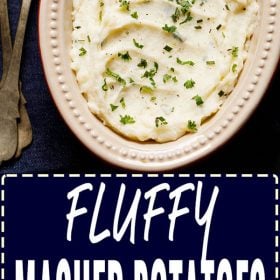
Hi Dassana,
You have mentioned an option of using full fat curd. I am keen to try this option, so how would it work?
Do you just skip the milk? And what about the butter; is it to be added?
Could you please give instructions on how the recipe is made using curd?
Tejal
Hi Tejal,
Yes, you can definitely try the mashed potatoes with full-fat curd. Just skip the milk and use curd instead. You can still add butter for richness; it pairs well with curd too.
First boil and then mash the potatoes. Ensure that the pan/bowl is on the kitchen countertop and not on the stove burner. Once the potatoes are mashed, add a few tablespoons of curd/yogurt (start with 2 to 3 tablespoons) and mix well. Then stir in the butter while the potatoes are still warm so it melts in smoothly. You can adjust the quantity of curd depending on how creamy and tangy you want it.
Let me know how it turns out!
I love your cooking, I do try your recipe cause I cook for people who is vegetarian so thank you very much..
Welcome and thanks.
Same results can be had for far less carbs by making this recipe with cauliflower. Steam the cauliflower until very tender and then blend in a food processor with garlic, herbs and a little cream cheese.
Great idea and thanks for sharing this variation made with cauliflower. Will try!
Simple but quite delicious. Thank you for sharing this.
Welcome and thanks.
Woww just wow.. They Turned out Amazing! This is the most elaborate and perfectly detailed Recipe I could find. Thanks a Bunch.
Happy to hear that. Most welcome.
so good…i adjusted the consistency by adding wee bit more milk and it was like a dip for chips.
could you post french onion veg soup recipe?
thank you for this lovely feedback. creamy smooth mashed potatoes can be had as a dip too. thanks again and yes, french onion soup will be coming up soon.
Really nice one.. What goes well along with this ? Is this a tea time one ?
thanks. mashed potatoes are served as a side for lunch or dinner. i usually make them as a side with some roasted vegetables or pasta and soup. i have already mentioned what vegetarian dishes can be served with mashed potatoes. with the leftovers, i make sandwiches or toasts.